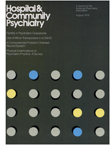The Use of Minor Tranquilizers in a Community Mental Health Center
Abstract
A study of 306 adult psychiatric outpatients visiting a CMHC during one month revealed that 55 per cent of those patients received a psychotropic medication and 45 per cent of the medication recipients used a minor tranquilizer as all or part of their treatment regimen. The most common diagnosis for patients receiving minor tranquilizers was depressive neurosis. The tranquilizers were prescribed in relatively high doses, and 57 of the 77 patients who received them had taken the drugs continuously for at least six months. The study also revealed that polypharmacy was widely practiced. The authors' suggestions for improving the quality of pharmacotherapy in a CMHC include instituting peer review of prescribing and recordkeeping practices and monitoring the effectiveness of medications through the application of quantitative mood scales at regular intervals.
Access content
To read the fulltext, please use one of the options below to sign in or purchase access.- Personal login
- Institutional Login
- Sign in via OpenAthens
- Register for access
-
Please login/register if you wish to pair your device and check access availability.
Not a subscriber?
PsychiatryOnline subscription options offer access to the DSM-5 library, books, journals, CME, and patient resources. This all-in-one virtual library provides psychiatrists and mental health professionals with key resources for diagnosis, treatment, research, and professional development.
Need more help? PsychiatryOnline Customer Service may be reached by emailing [email protected] or by calling 800-368-5777 (in the U.S.) or 703-907-7322 (outside the U.S.).



